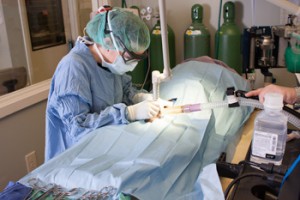 Veterinary laser surgery has been around for decades, but only recently it has become the go-to answer for better, faster, and easier pet health care.
Veterinary laser surgery has been around for decades, but only recently it has become the go-to answer for better, faster, and easier pet health care.
While there are different types of lasers out there, the CO2 laser is one of the best options available. Not only is the laser one of the most accurate available in the market, but it can also be used for a variety of surgical situations.
What’s the (Laser) Point?
What makes the CO2 laser so good? Well, for starters, it…
- Causes less bleeding. This means faster healing, but also fewer chances of complications during surgery. Plus, less bleeding means pets won’t feel as weak after surgery and will recover faster.
- Reduces the risk of infection. Because lasers cauterize as they cut, the bleeding is minimal and the incisions are smaller. In addition, the heat of the laser has a sterilizing effect, so it kills bacteria while the surgery is underway.
- Results in less pain. This is perhaps one of the most important considerations for pet owners. Compared to traditional scalpel surgery, veterinary laser surgery is a lot less painful. This is because the laser seals nerve endings as it cuts through skin and muscle. During post-surgery recovery, this means animals suffer less discomfort and pain, need fewer pain medication and anti-inflammatories, and often are up and going within hours of coming out of the anesthesia.
Using Laser for Episioplasty Surgeries
Laser surgery can be performed in a number of situations, but it’s particularly suited for certain conditions. For example, pets can highly benefit from having spays and episioplasty surgeries performed with laser. Episioplasty surgeries are also known as vulvoplasties and are done to remove excess skin that covers the vulva.
The excess skin causes bacteria from debris and urine to be caught in between the folds. This can lead to serious infections, including chronic UTIs (urinary tract infections). Removing the excess skin with CO2 veterinary laser surgery is ideal because the method is highly precise, which enables the veterinarian remove only as much skin as necessary.
A Good Option for Declawing
Laser surgery is also a better method for declawing cats, although not all veterinarians perform this kind of surgery. For those that do, however, traditional declaws are highly painful and require long and extensive post-operative care in order to prevent infections and help cats readapt to their new situation. Laser declawing, on the other hand, produces almost no bleeding and it greatly reduces their pain. This means cats go back to their normal routine much faster. In most cases, they don’t even need bandages or other extensive care required by pets undergoing traditional declawing.
Laser for Oral Surgeries
Finally, veterinary laser surgery is also a good option for oral surgeries such as full mouth extractions and elongated soft palate surgery. The brachycephalic airway syndrome is a common occurrence in dogs and cats with flat faces, such as Bulldogs and Boxers. Soft palates are usually longer than they should be, and that length can block part of the trachea, causing breathing difficulties. Laser can be used to cut away part of that excess, improving quality of life and making breathing easier and more comfortable. While this surgery can also be performed with traditional tools, laser is especially helpful because the area is highly sensitive and prone to a lot of bleeding and pain.
If you have questions or concerns regarding the use of laser for your pet’s next surgery, give us a call at Harmony Animal Hospital or visit us at www.www.harmonyanimalhospital.net and let our veterinarians help you understand the benefits of this new technology for your pet.

